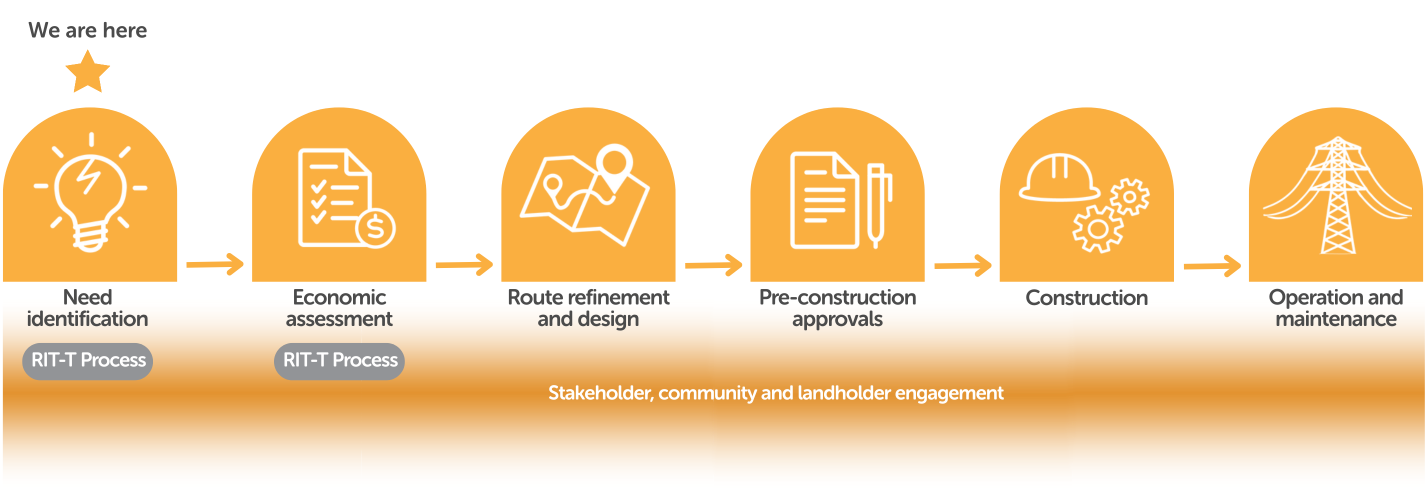Waddamana to Palmerston
Location
Waddamana (Central Highlands) to Palmerston substation (Near Cressy, Northern Midlands)
Traditional name
Yingina/Great Lake
Overview
The Waddamana to Palmerston transfer capability project has been identified as an “actionable project” in the Integrated System Plan (ISP), prepared and published by Australian Energy Market Operator (AEMO). The ISP provides an integrated roadmap for the efficient development of the National Electricity Market (NEM) over the next 20 years and beyond.
The Waddamana to Palmerston transmission lines are critical for energy security in Tasmania as they provide the only transmission link between the north and south of the State.
There is enormous potential for future renewable energy developments in the Central Highlands.
The Central Highlands transmission network, including the Waddamana to Palmerston transmission lines, will play an important role in ensuring this renewable energy finds its way to Tasmanian homes and businesses, including future Tasmanian industries, with excess energy supplied to the NEM.
TasNetworks is currently exploring options to make best use of the transmission network already established between Waddamana and Palmerston substations and are exploring options to expand the network to increase both capacity and energy security.
These options are being assessed through the robust AER process referred to as a Regulatory Investment Test for Transmission (RIT-T).
Options being explored take into consideration environmental, community and stakeholder feedback and technical constraints, economic benefits, and future network capacity.
Options already explored have included seeking proponents to install non-network solutions (such as large-scale energy storage) to best utilise the existing Waddamana to Palmerston network.
Map

Timeline

We are prioritising engagement with stakeholders and the community at this early phase in the project to gain insights about the local area, local values, and local needs. This valuable feedback will help inform decision making.
Survey coming soon
You can provide feedback by emailing majorprojects@tasnetworks.com.au
Or calling: 1300 127 777
Upcoming engagement:
Times and locations of community information sessions will be advertised soon.
The Regulatory Investment Test for Transmission (RIT-T) Process
The RIT-T is designed to help identify the most appropriate future investment that will maximise market benefits when managing capacity on the Waddamana to Palmerston transmission corridor, while ensuring that costs borne by network users are transparent and justifiable.
As an ISP actionable project, the RIT-T process is required to be applied in line with the Australian Energy Regulator’s cost benefit analysis guideline. This guideline expects the RIT-T to explore the credible options at a more granular technical level (including by exploring refinements) and explore non network options that AEMO has had a limited opportunity to assess.
Two main documents will be produced and consulted on:
- The Project Assessment Draft Report (PADR) describes the results of the cost benefit analysis and identifies the preferred option.
- The Project Assessment Conclusion Report (PACR) confirms the preferred option and provides a summary of submissions and responses received during the PADR.
Next Steps
We intend to publish the PADR by 26 June 2025. The PADR will include:
- A description of which credible options have been assessed.
- Indicative costs of each credible option.
- A description of the methodologies used to quantify costs and benefits.
- A net present value analysis for each credible option.
- A proposed preferred option, taking into account the net present value analysis as well as any other considerations deemed appropriate and allowable within the RIT-T framework.
Formal engagement opportunity
While your feedback will be used in our decision-making process, you also can provide feedback formally through the RIT-T Process.
Once the PADR is published, TasNetworks will seek stakeholder submissions over a 6 week period on the various issues and preferred option presented in the PADR.
Once the PACR is published there is a 30 day dispute period.
Frequently Asked Questions
-
What is TasNetworks role?
As Tasmania’s transmission network service provider, TasNetworks is responsible for delivering this project which will support the forecast increase in renewable generation in the Central Highlands. As a first step, TasNetworks must undertake the Regulatory Investment Test for Transmission (RIT-T).
-
What is the RIT-T?
The RIT-T is a public cost benefit analysis that TasNetworks must apply to most large investments in the transmission network. The purpose of the RIT-T is to identify the option (network or non-network) to address a need that delivers the greatest net benefits to customers.
-
Why is the project needed?
The existing network in the Central Highlands candidate renewable energy zone (REZ) is insufficient to support the projected growth in new wind generation required to meet the Tasmanian Renewable Energy Target (TRET). Therefore, investment is needed to:
- increase power system capability of the transmission network between Central and North Western Tasmania, and
- support the expected increase in renewable generation in Central Highlands candidate REZ in the vicinity of the Waddamana region.
-
What are the timeframes for the project?

The first RIT-T report, the Project Assessment Draft Report (PADR), is due to be shared with all stakeholders by June 26th, 2025. The PADR will present the reasoning for choosing the preferred option.
Following the release of this report, stakeholders can provide written submissions for at least six weeks.
Following consideration of stakeholder feedback received during the PADR consultation period, TasNetworks will release the final RIT-T report, the Project Assessment Conclusions Report (PACR).The PACR:
- Summarises and responds to issues raised in consultation on the PADR
- Revises the cost-benefit analysis based on feedback and updated information
- Confirms (or updates) the preferred solution
- Outlines the intended course of action
-
How does TasNetworks determine the preferred option in the RIT-T?
The RIT-T is an economic assessment that for credible options to address an identified need considers benefits and costs to all participants in the National Electricity Market.
For this project, TasNetworks is assessing whether the costs of increasing the capability of the Waddamana – Palmerston transmission network are lower than the benefit derived from providing access to high quality and low-cost energy resources. The preferred option is the one which maximises the net economic benefit.
-
What elements are considered as part of the transmission route selection process?
Should the preferred option require the construction of new transmission lines, TasNetworks will undertake further analysis to determine the final route.
This will consider a range of factors, including:
- Cost
- Constructability
- Stakeholder feedback
- Transmission system security and performance
- Environmental and social aspects including occupation, land use, native vegetation, threatened ecological communities and species, planning controls and geomorphology
- Heritage values
TasNetworks seeks to minimise adverse impacts on landowners, businesses and conservation areas. We will consider tourism , visual amenity, high value agriculture and broader community values.
-
Why is a new corridor being considered when there is an existing corridor?
A diverse corridor for a new transmission line would improve transmission network reliability, reduce technical constraints of crossing Arthurs Lake and constructing down the steep terrain over the Western Tiers which is known for high land slip potential. It would provide high-capacity circuits for North / South power flows and have a longer asset life.
A resilient power system will ensure the risk and impact of “high impact, low probability” (HILP) events is minimised. HILP events include those such as landslide, lightning, bushfires, extreme wind, or other events affecting all transmission lines within a single corridor. These events can cause widespread and sustained interruptions, and in worst cases a “system black”.
-
If a new corridor was selected would the existing corridor remain?
Yes, the existing easement and transmission lines would remain as it is. Waddamana–Palmerston upgrade is in addition to the existing network capability, and the existing corridor would continue to operate as a critical network connection between the North and South of the state with the new corridor providing important route and network diversity.
-
How will TasNetworks ensure that the environment is protected for the project?
All transmission line projects are subject to rigorous environmental assessment.
These assessments include detailed field surveys to identify any natural values that may potentially be impacted upon by the project.For construction to commence, TasNetworks is required to demonstrate to the satisfaction of the relevant statutory regulators, which could include the EPA or the Commonwealth, how those potential impacts may be minimised, mitigated or managed.
-
What will be done to understand Tasmanian Aboriginal connection for this project?
Relationship building with Tasmanian Aboriginal community members and organisations remains a focus, aligning with TasNetworks’ Innovate Reconciliation Action Plan (RAP) and supported by the TasNetworks Aboriginal Engagement Advisor.
-
If I provide feedback, how will it be used?
All feedback that is received will be collated and presented in a summary, that will feed into the draft report ahead of the decision on the direction of the project.
-
How will landholders be engaged with on this project?
Each land owner will be contacted by one of the TasNetworks land engagement specialists. Who will work to provide information and a conduit for feedback on the project, back into TasNetworks.
- If you are a land owner and haven’t heard from TasNetworks please send an email to: sonya.booth@tasnetworks.com.au
-
How will recreation groups be engaged with on this project?
TasNetworks is seeking feedback from several recreational groups who have been identified as interested parties in this area. We are seeking their insights as to how they use this area, and what are the key considerations for these communities. We are seeking to better understand how the land is used and what can we learn from local knowledge.
- If you are a member of a recreation group who has interest in this area, please feel free to contact us as we would love to hear from you: majorprojects@tasnetworks.com.au
-
How does this project relate to the Tasmanian Renewable Energy Target (TRET)?
The Tasmanian Government-legislated Tasmanian Renewable Energy Target (TRET) is for renewable energy sources to produce 200% of our electricity needs from 2020 by 2040, with 150% by 2030. From that 2020 energy demand baseline of 10,500 GWh (gigawatt hours), the target is to produce 15,750 GWh in one year by 2030 and 21,000 GWh in one year by 2040.
More information on TRET is available here: https://recfit.tas.gov.au/what_is_recfit/energy_vision/200_renewable_energy_target
Most of this new energy is expected to come from large-scale renewable energy sources connected to the transmission network predominately wind farms, with contribution also from solar farms.
The Central Highlands area has excellent wind resource, with proximity to the transmission network. This makes it a strong candidate to host a large portion of the new wind energy to achieve the TRET. Upgrade of the Waddamana–Palmerston transmission corridor is required to ensure the transmission network can accommodate these new renewable energy resources.

